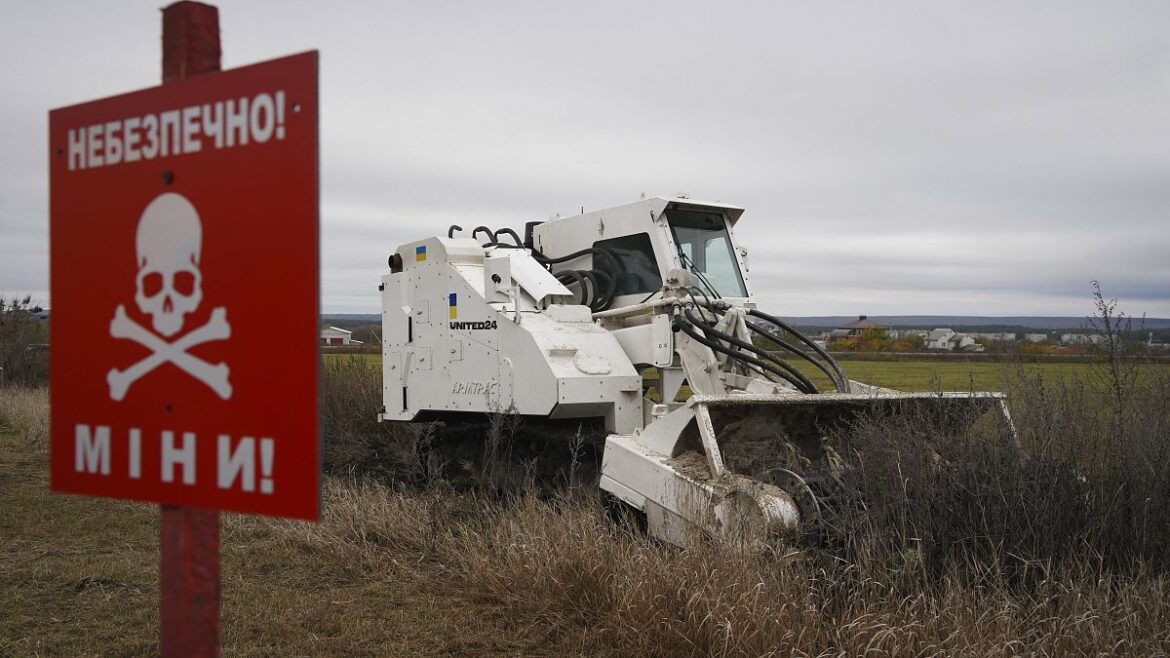Ukraine is now the most mined country in the world, and it will take up to 30 years to complete the clearance of mines and unexploded ordnance, as a third of its territory is potentially dangerous.
After more than two and a half years of invasion by Russia, Ukraine is now the most mined country in the world.
According to the Ukrainian Humanitarian Demining Association, complete demining of Ukrainian territory could take up to 30 years.
The association indicates that more than 156,000 square kilometers are potentially dangerous, or a third of the country’s surface area.
“One day of war is equivalent to 30 days of mine clearance. In the case of the city of Irpin, this is true”Yakiv Hanul, the head of the pyrotechnic department of Irpin, Kyiv region, told Euronews.
Not all mines and unexploded ordnance can be identified immediately, he adds, further complicating mapping and clearance efforts.
“Some mines or unexploded ordnance are in private areas. Without external signs, no one will go there unless residents or owners make a phone call.”explains Yakiv Hanul.
“Moreover, shells have undoubtedly landed in bodies of water – lakes, rivers, swamps. They are also not immediately detected. This is why one day of war is equivalent to 30 days of mine clearance. And whatever ‘be that as it may, part of it will always remain in the ground’he adds.
Colossal mine clearance costs
The World Bank estimates the total cost of removing explosive devices at around 34 billion euros, and more than 10,000 experts will be needed to carry out this work. Currently, Ukraine has only about 3,000 sappers capable of handling mines and unexploded ordnance.
The State Emergency Service of Ukraine organizes special training programs, including the identification of dangerous explosive devices.
Nataliia Kirkina is one of the participants in this program. A former police captain from Sievierodonetsk in the Luhansk region, she enrolled in the program when she returned to Irpin after Ukrainian forces chased Russian soldiers out of the Kyiv region.
“When I was a child, my father accidentally found a grenade fuse from World War II. It exploded in his hands. He miraculously survived”Nataliia Kirkina tells Euronews.
“I didn’t want my children to experience the same thing. So I resigned from the national police and trained to become an explosive ordnance identifier”.
Train firefighters today so tomorrow is safer
Before 2022, only men could work as explosive ordnance disposal operators in Ukraine, but when Ukrainian men left for the front, the profession opened up to womenan increasing number of whom are enrolling in training programs in their country and abroad.
One of these schools is MAT Kosovo, which offers a special program for Ukrainian women.
Sir Ben Remfrey, managing director of Praedium Consulting Malta and MAT Kosovo, told Euronews that the school was in negotiations with UN Women to launch a project to train many more women in 2025-2026.
More than 400 Ukrainian women have already been trained at the establishment located in Peja, in western Kosovo. They acquire unique skills in accordance with international demining standards, taught in their native language, since MAT Kosovo has translated all its courses into Ukrainian.
The school’s CEO explains that there is no one-size-fits-all training approach.
“The training focuses on what type of operational role they will have when they return to Ukraine and how they will conduct operations themselves as team members or leaders”explains Ben Remfrey.
“The threats posed have been carefully studied and training has been adapted to this, as well as to evolving threats. As the war continues and new areas are liberated, the type of threat changes, from elimination of conventional devices to that of traps and improvised devices, for example”.
Sir Ben Remfrey adds thatit is important to start mine clearance in Ukraine as soon as possible.
“Displaced people will return home as soon as they can, people who worked the land will want to work it again, they will want to live in their old homes and move around as they did before in complete safety”he declares.
Three categories of mine clearance
Mine clearance is generally divided into three categories: operational demining, military demining and humanitarian demining.
Operational mine clearance is carried out in an emergency by state services, police sappers and specialists of the special transport service.
Military mine clearance is carried out by soldiers to clear a path for the army to advance during a conflict. In this case, mines are only deactivated if they block strategic routes necessary for the advance or retreat of soldiers in war.
Finally, the main objective of humanitarian demining is to “clear” an area so that civilians can return to their homes and carry out their daily activities without putting their lives in danger.
Saving the lives of deminers thanks to robots
To help emergency services and save the lives of explosives specialists, Ukraine increasingly uses ground robotic systems.
UNITED24the official fundraising platform created at the initiative of President Volodymyr Zelensky, explains that the use of ground robots significantly increases the speed of mine clearance and guarantees the absolute safety of the operator.
“The operator can be at a distance of up to 3 kilometers from the mine-clearing robot, which guarantees its complete safety and allows it to clear up to 100 square meters per day, which is 10 times more than the mine-clearing capabilities of ‘a sapper’explains Taras Ostapchuk, drone developer.
However, these calculations only concern the territories already liberated by Ukrainian forces. Clearing mines from areas where heavy fighting has taken place for a long time will pose an even greater problem after their liberation.
“There are areas in the Donetsk region where neither we nor the enemy have made progress since the beginning of the war”says Yakiv Hanul.
“There, the fighting on these already destroyed lands has lasted for almost three years. There are millions of pieces of debris and unexploded ordnance”.



